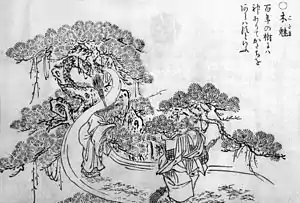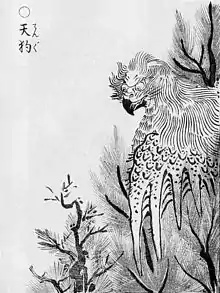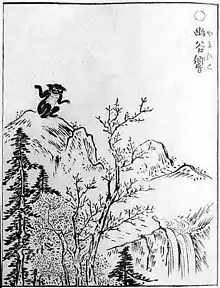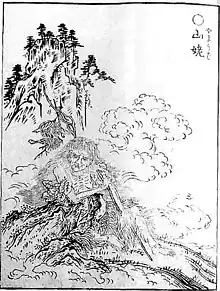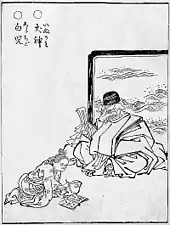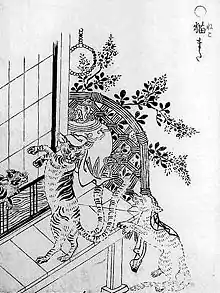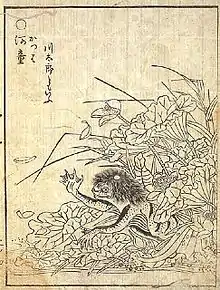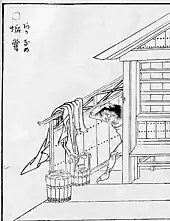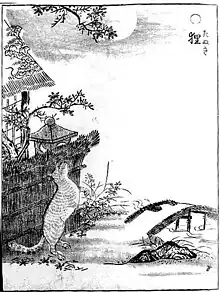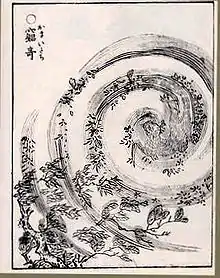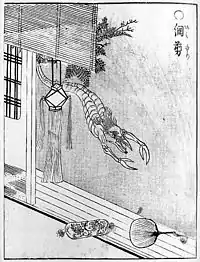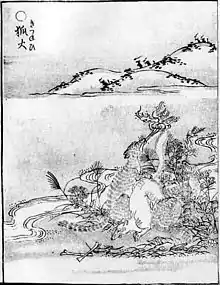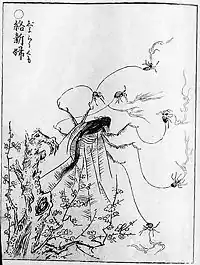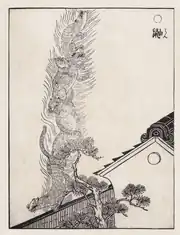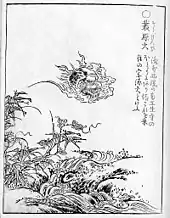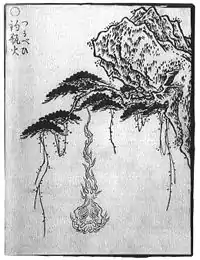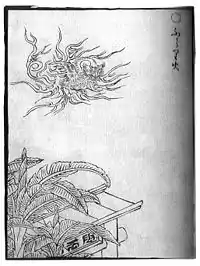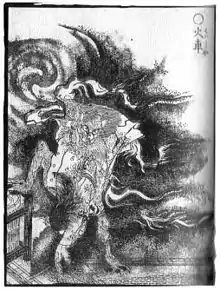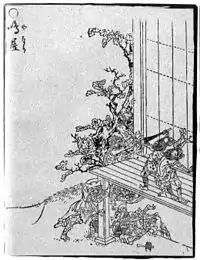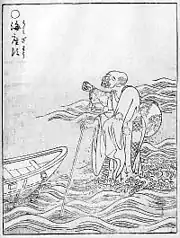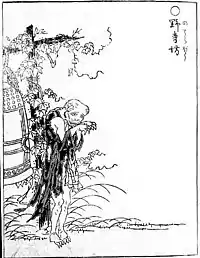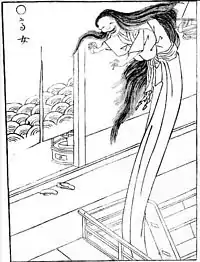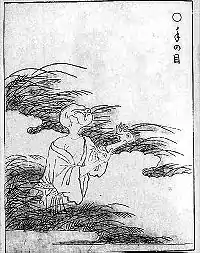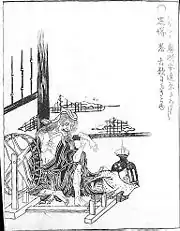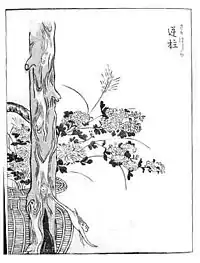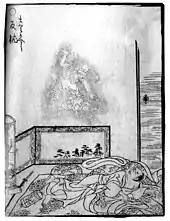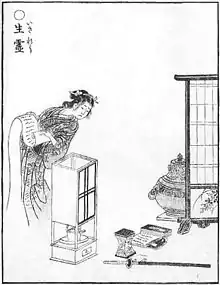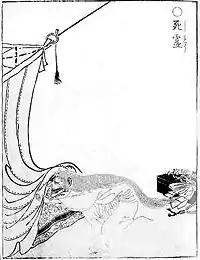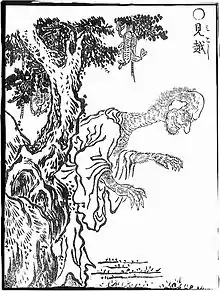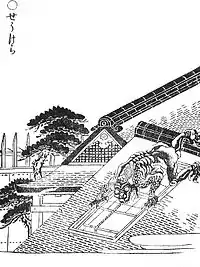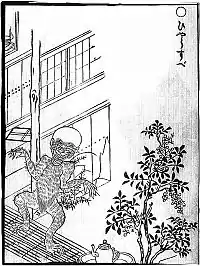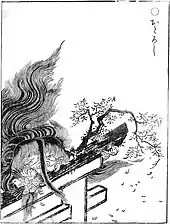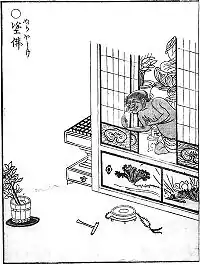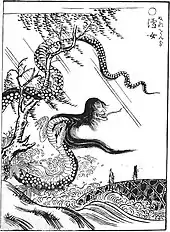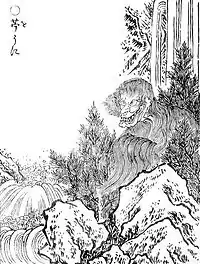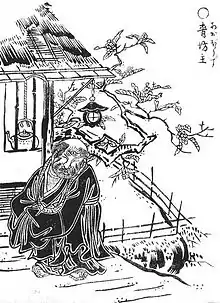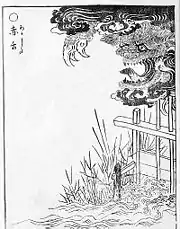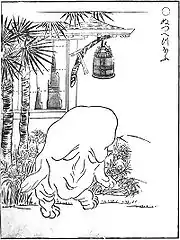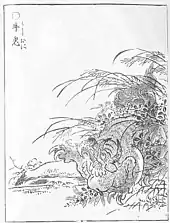Gazu Hyakki Yagyō (画図百鬼夜行, "The Illustrated Night Parade of a Hundred Demons" or The Illustrated Demon Horde's Night Parade) is the first book of Japanese artist Toriyama Sekien's famous Gazu Hyakki Yagyō e-hon tetralogy, published in 1776. A version of the tetralogy translated and annotated in English was published in 2016.[1] Although the title translates to "The Illustrated Night Parade of a Hundred Demons", it is based on an idiom, hyakki yagyō, that is akin to pandemonium in English and implies an uncountable horde.[2] The book is followed by Konjaku Gazu Zoku Hyakki, Konjaku Hyakki Shūi, and Gazu Hyakki Tsurezure Bukuro.
The book is a supernatural bestiary, a collection of ghosts, spirits, spooks and monsters from literature, folklore, and other artwork. The art of Gazu Hyakki Yagyō heavily references a 1737 scroll-painting called the Hyakkai Zukan by artist Sawaki Sūshi;[3] Sekien's innovation was preparing the illustrations as woodblock prints that could be mass-produced in a bound book format.[4] Intended as a parody of then-popular reference books such as the Wakan Sansai Zue, it ended up becoming a reference book in its own right, profoundly influencing subsequent yōkai imagery in Japan.[5] The book proved popular enough to be reprinted three times over the course of the Edo era by various book-sellers.[6] The book is compiled in three sub-volumes: Yin, Yang, and Wind. Yin features a foreword by poet Maki Tōei, while Wind ends with an afterword by Sekien.[7]
First Volume "Yin" – 陰
The first volume of Gazu Hyakki Yagyō, called "Yin", includes the following yōkai.
Second Volume "Yang" – 陽
The second volume of Gazu Hyakki Yagyō, called "Yang", includes the following yōkai.
Third Volume "Wind" – 風
The third volume of Gazu Hyakki Yagyō, called "Wind", includes the following yōkai.
See also
References
- ↑ Yoda, Hiroko; Alt, Matt (2016). Japandemonium Illustrated: The Yokai Encyclopedias of Toriyama Sekien. Dover Publications. ISBN 978-0-486-80035-6.
- ↑ Yoda, Hiroko; Alt, Matt (2016). Japandemonium Illustrated: The Yokai Encyclopedias of Toriyama Sekien. Dover Publications. p. vi. ISBN 978-0-486-80035-6.
- ↑ Yoda, Hiroko; Alt, Matt (2016). Japandemonium Illustrated: The Yokai Encyclopedias of Toriyama Sekien. Dover Publications. p. 11. ISBN 978-0-486-80035-6.
- ↑ Foster, Michael Dylan (2009). Pandemonium and Parade: Japanese Monsters and the Culture of Yokai. University of California Press. p. 56.
- ↑ Yoda, Hiroko; Alt, Matt (2016). Japandemonium Illustrated: The Yokai Encyclopedias of Toriyama Sekien. Dover Publications. p. viii. ISBN 978-0-486-80035-6.
- ↑ Yoda, Hiroko; Alt, Matt (2016). Japandemonium Illustrated: The Yokai Encyclopedias of Toriyama Sekien. Dover Publications. p. xiv. ISBN 978-0-486-80035-6.
- ↑ Yoda, Hiroko; Alt, Matt (2016). Japandemonium Illustrated: The Yokai Encyclopedias of Toriyama Sekien. Dover Publications. pp. 3–5. ISBN 978-0-486-80035-6.
Bibliography
- Yoda, Hiroko (2017). Japandemonium Illustrated: The Yokai Encyclopedias of Toriyama Sekien. New York: Dover Publications. ISBN 978-0-486-80035-6.
- Toriyama, Sekien (July 2005). Toriyama Sekien Gazu Hyakki Yagyō Zen Gashū (in Japanese). Tokyo: Kadokawa Shoten Publishing Co., Ltd. pp. 10–65. ISBN 978-4-04-405101-3.
- "Hyakki Zufu Obake Iroha Sakuin". CSK Pavilion: Hyakki Yagyō. Retrieved 2007-04-22.
